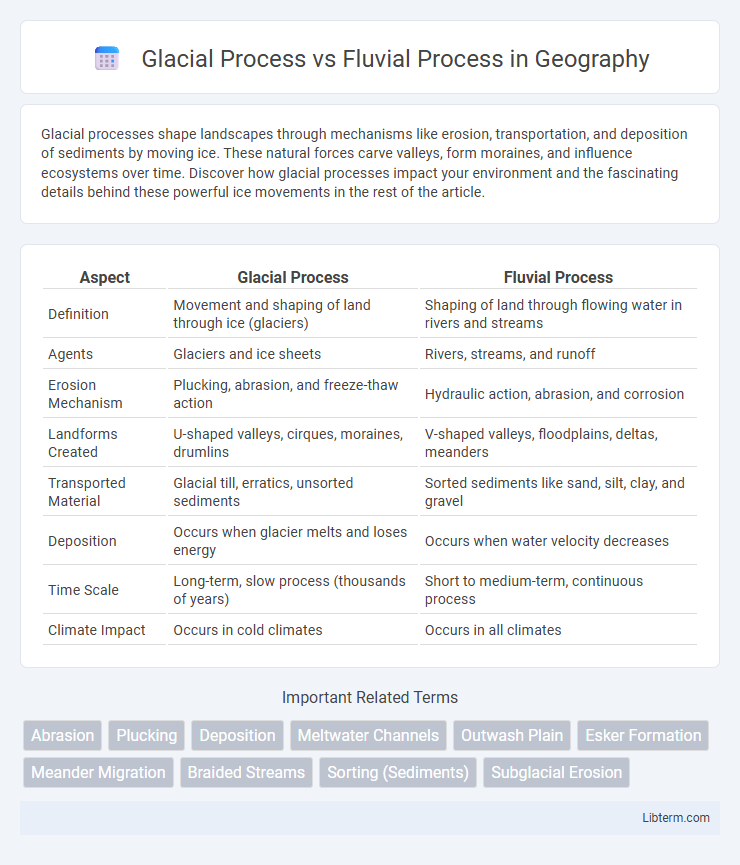Glacial processes shape landscapes through mechanisms like erosion, transportation, and deposition of sediments by moving ice. These natural forces carve valleys, form moraines, and influence ecosystems over time. Discover how glacial processes impact your environment and the fascinating details behind these powerful ice movements in the rest of the article.
Table of Comparison
| Aspect | Glacial Process | Fluvial Process |
|---|---|---|
| Definition | Movement and shaping of land through ice (glaciers) | Shaping of land through flowing water in rivers and streams |
| Agents | Glaciers and ice sheets | Rivers, streams, and runoff |
| Erosion Mechanism | Plucking, abrasion, and freeze-thaw action | Hydraulic action, abrasion, and corrosion |
| Landforms Created | U-shaped valleys, cirques, moraines, drumlins | V-shaped valleys, floodplains, deltas, meanders |
| Transported Material | Glacial till, erratics, unsorted sediments | Sorted sediments like sand, silt, clay, and gravel |
| Deposition | Occurs when glacier melts and loses energy | Occurs when water velocity decreases |
| Time Scale | Long-term, slow process (thousands of years) | Short to medium-term, continuous process |
| Climate Impact | Occurs in cold climates | Occurs in all climates |
Understanding Glacial Processes
Glacial processes involve the movement and transformation of ice masses, primarily through accumulation, compaction, and flow of glaciers, shaping landforms like moraines, drumlins, and U-shaped valleys. These processes result from glacial erosion, transportation, and deposition, influencing landscapes in cold climates through mechanisms like plucking and abrasion. Understanding glacial dynamics is essential for interpreting past climate changes, sediment distribution, and the geomorphology of glaciated regions.
Fundamentals of Fluvial Processes
Fluvial processes involve the movement and deposition of sediment by rivers and streams, driven primarily by the flow of water. These processes include erosion, transportation, and deposition, which shape river valleys and floodplains through mechanisms like hydraulic action, abrasion, and sediment load management. Understanding channel patterns, sediment transport capacity, and discharge variability is fundamental for analyzing river dynamics and landscape evolution.
Key Differences Between Glacial and Fluvial Processes
Glacial processes involve the movement and erosion caused by glaciers, characterized by features like U-shaped valleys, moraines, and striations, while fluvial processes are driven by rivers and streams, creating V-shaped valleys, alluvial fans, and river terraces. Glacial erosion primarily occurs through plucking and abrasion under ice masses, whereas fluvial erosion results from hydraulic action, abrasion, and solution by flowing water. Sediment transport in glacial systems includes unsorted till and erratics, contrasting with the sorted and stratified sediments typical of fluvial deposits.
Erosional Mechanisms in Glacial Environments
Glacial erosional mechanisms primarily include plucking and abrasion, where moving ice detaches and grinds bedrock, reshaping landscapes with striations and U-shaped valleys. Subglacial meltwater also contributes through hydraulic action, enhancing sediment removal beneath glaciers. These processes contrast with fluvial erosion, which relies on the kinetic energy of flowing water to transport and erode sediments via hydraulic action, abrasion, and solution.
Erosion in River Systems: Fluvial Dynamics
Fluvial dynamics drive erosion primarily through the movement of water in river systems, where hydraulic action, abrasion, and solution work collectively to shape riverbeds and banks. Unlike glacial processes that involve ice movement and plucking, fluvial erosion is dominated by sediment transport and channel incision. Key factors influencing fluvial erosion include flow velocity, discharge rates, sediment load, and channel morphology, which together control landscape evolution in riverine environments.
Glacial Deposition: Landforms and Features
Glacial deposition creates distinctive landforms such as moraines, drumlins, and eskers, formed by the accumulation and movement of glacial till and outwash sediments. Moraines are ridges of unsorted debris deposited at glacier edges, while drumlins are streamlined hills shaped beneath moving ice. Eskers are sinuous ridges of sand and gravel deposited by subglacial meltwater streams, revealing the dynamic interplay between ice and sediment transport.
Fluvial Deposition: Sediment Transport and Landform Development
Fluvial deposition involves the transport and settling of sediments by river systems, shaping various landforms such as floodplains, deltas, and alluvial fans. Sediment transport in fluvial processes occurs through bed load, suspended load, and dissolved load, influencing channel morphology and sediment distribution. Over time, the accumulation of deposited materials leads to the development of fertile soils and distinct landscapes, critical for ecosystem habitats and human agriculture.
Influences of Climate on Glacial and Fluvial Processes
Glacial processes are heavily influenced by climate variables such as temperature and precipitation, where cold climates promote glacier formation and movement through accumulation and ablation cycles, shaping landscapes via erosion and deposition. Fluvial processes depend on climate-driven precipitation patterns and temperature, affecting river discharge, sediment transport, and channel morphology. Variations in climate dictate the dominance and intensity of glacial versus fluvial erosion, directly impacting geomorphological features and sediment dynamics.
Human Impact on Glacial and Fluvial Landscapes
Human activities significantly alter glacial and fluvial landscapes through various interventions. In glacial areas, infrastructure development, mining, and tourism accelerate ice melt and cause habitat disruption, while in fluvial systems, dam construction, deforestation, and urbanization modify river flow patterns, increase sedimentation rates, and affect aquatic ecosystems. These impacts result in altered sediment transport, increased erosion, and changes in water availability, threatening biodiversity and regional water resources.
Comparing the Geomorphic Significance of Glacial vs Fluvial Processes
Glacial processes sculpt landscapes through erosion, transportation, and deposition of sediments, creating distinctive landforms like U-shaped valleys, moraines, and drumlins, which reflect intense, large-scale reshaping over long periods. Fluvial processes, driven by the movement of rivers and streams, primarily shape landscapes by channel incision, sediment sorting, and floodplain development, leading to V-shaped valleys, alluvial fans, and deltas that respond dynamically to climatic and hydrologic variations. The geomorphic significance of glaciers lies in their ability to modify vast mountainous and polar regions with cold climates, while fluvial systems dominate sediment redistribution and landscape evolution in diverse environments worldwide.
Glacial Process Infographic

 libterm.com
libterm.com